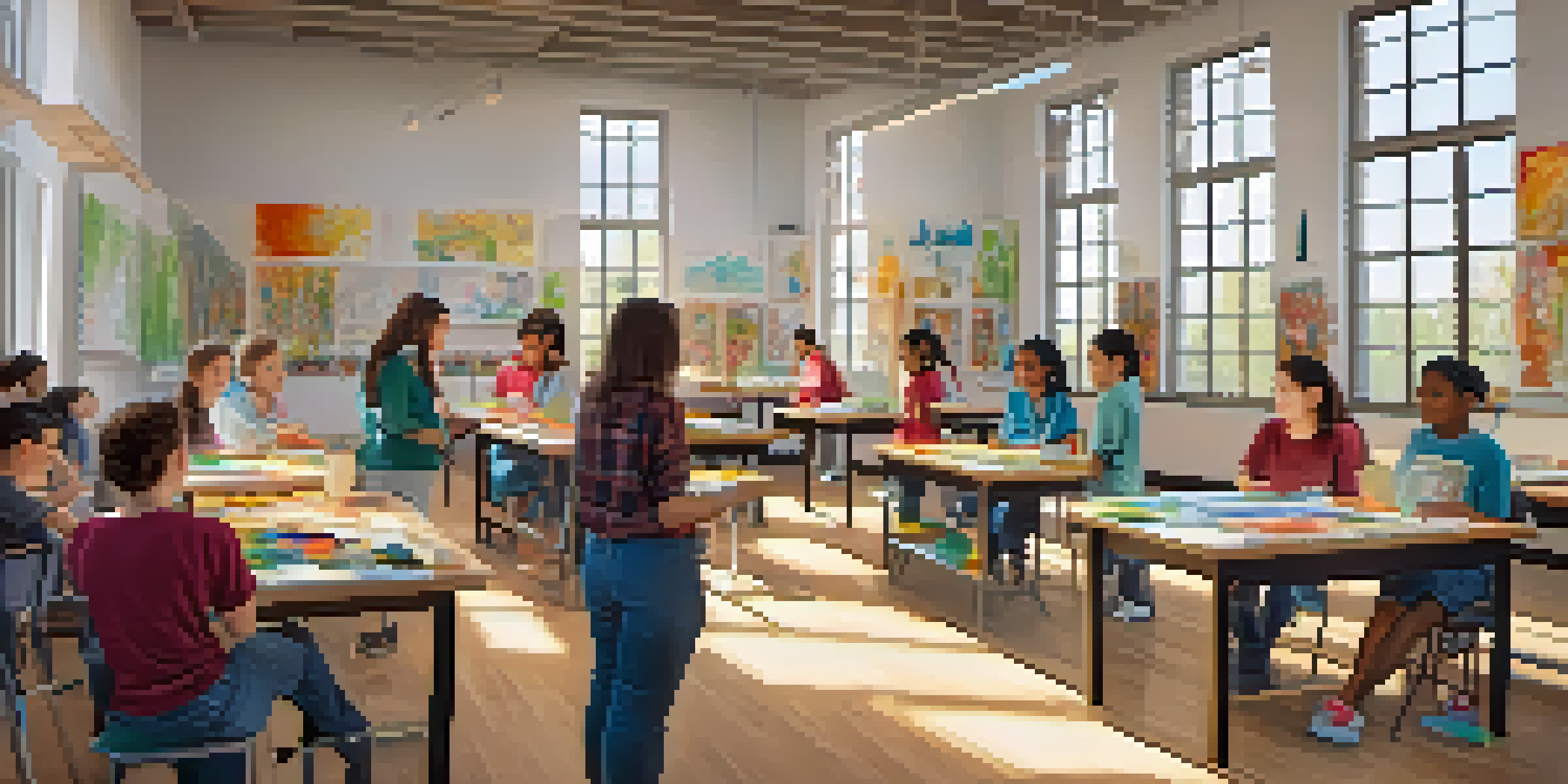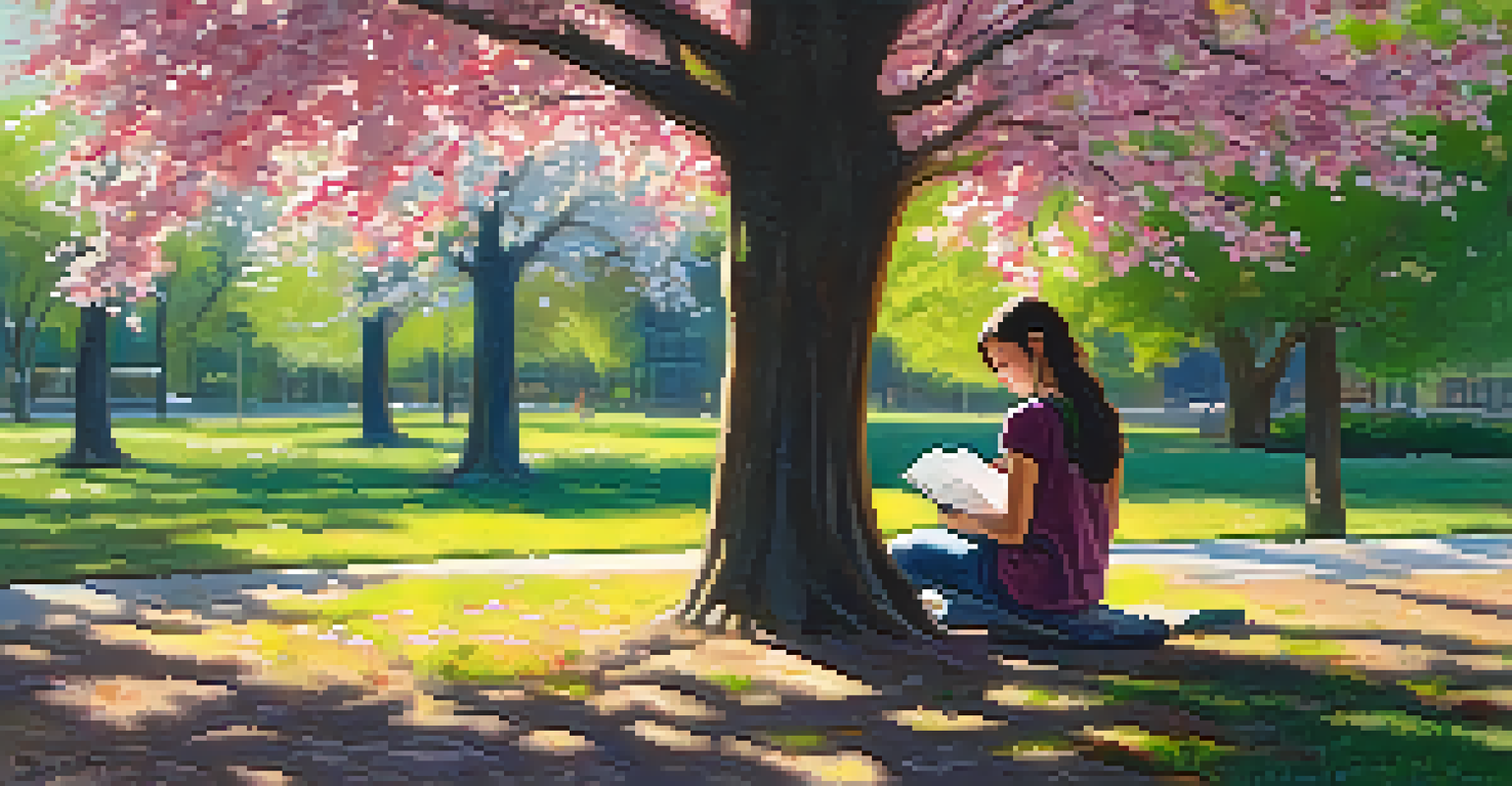Benefits of Extracurricular Art Programs in Schools

Enhancing Creativity Through Art Programs
Extracurricular art programs provide students with a platform to express their creativity. Engaging in activities like painting, sculpture, or drama allows students to explore their unique artistic voices. This creative outlet is essential for personal development and can boost students' confidence in their abilities.
Every artist was first an amateur.
Moreover, these programs encourage innovative thinking, which is crucial in today's fast-paced world. When students tackle artistic challenges, they learn to approach problems from various angles, fostering a mindset that values creativity. This skill is not only beneficial in art but also transfers to other academic subjects and real-life situations.
Ultimately, by participating in art programs, students can discover hidden talents and passions. This journey of self-discovery can lead to lifelong interests and career paths, making art education a vital component of a well-rounded school experience.
Building Social Skills Through Collaboration
Art programs often involve teamwork, where students collaborate on projects or performances. This cooperative environment helps students develop essential social skills, such as communication and empathy. Working together towards a common goal fosters a sense of community and belonging among participants.

As students share ideas and give constructive feedback, they learn to appreciate diverse perspectives. This exchange of thoughts not only enhances their artistic endeavors but also cultivates respect for others' opinions. Such interpersonal skills are invaluable, as they apply to academic settings and future workplaces.
Art Boosts Creativity and Confidence
Extracurricular art programs allow students to express their creativity, leading to personal growth and increased confidence.
Additionally, these collaborative experiences can forge lasting friendships. When students bond over shared artistic experiences, they create memories that contribute to their overall school experience and personal growth.
Boosting Academic Performance Through the Arts
Participating in art programs has been linked to improved academic performance across various subjects. Engaging in creative activities can enhance students' focus, discipline, and problem-solving skills, which are essential for academic success. These skills often translate into better grades and a deeper understanding of complex concepts.
Art is the most beautiful of all lies.
Research shows that students involved in the arts tend to perform better on standardized tests. The critical thinking and analytical skills developed through artistic expression help them tackle academic challenges more effectively. In this way, art education complements traditional learning methods.
Furthermore, integrating art into the curriculum can make learning more enjoyable and relatable. When students can connect academic subjects with creative expression, they are more likely to stay engaged and motivated in their studies.
Fostering Emotional Intelligence and Resilience
Extracurricular art programs play a significant role in developing emotional intelligence among students. By exploring their feelings through art, students learn to understand and manage their emotions better. This self-awareness is crucial for building healthy relationships and navigating life's challenges.
Art also provides a safe space for students to express their thoughts and feelings. This outlet can be especially beneficial for those who may struggle with traditional forms of communication. As they create, students can process their experiences, leading to improved mental health and emotional resilience.
Collaboration Builds Social Skills
Working together on art projects helps students develop vital social skills like communication and empathy.
Moreover, encountering setbacks in the creative process teaches students about persistence and growth. Learning to embrace failure as part of the artistic journey prepares them for future challenges, both in and out of the classroom.
Cultivating Cultural Awareness and Appreciation
Art programs often expose students to various cultures and artistic traditions. This exposure fosters a deeper understanding and appreciation of diversity, which is essential in our interconnected world. By learning about different artistic styles and histories, students gain insights into the values and experiences of others.
Such cultural awareness can enhance students' empathy and global perspective. Recognizing the richness of various cultures through art can help break down stereotypes and promote inclusivity. This understanding is vital in creating a harmonious school environment.
Additionally, art education encourages students to celebrate their own cultural backgrounds while exploring others. This dual appreciation enriches their creative expression and strengthens their identity, contributing to a more inclusive school community.
Encouraging Lifelong Skills and Passions
Participating in extracurricular art programs can ignite a lifelong passion for the arts. Students often discover interests they may not have explored otherwise, leading to hobbies or careers in creative fields. This engagement can significantly enhance their quality of life and personal fulfillment.
Moreover, the skills learned in art programs—such as discipline, critical thinking, and time management—are applicable in various aspects of life. These abilities can benefit students well beyond their school years, providing a solid foundation for professional success.
Art Enhances Academic Performance
Participation in art programs is linked to improved focus and critical thinking, which translates to better academic outcomes.
As students develop their artistic talents, they also cultivate a sense of pride and accomplishment. This confidence can inspire them to pursue new challenges and adventures, whether related to the arts or other areas of interest.
Providing a Healthy Outlet for Stress Relief
In today's fast-paced academic environment, students often face significant stress. Extracurricular art programs offer a constructive outlet for this pressure, enabling students to unwind and express their emotions creatively. Engaging in artistic activities can be therapeutic, helping to reduce anxiety and promote mental well-being.
Creating art allows students to focus on the present moment, providing a break from academic demands. This mindfulness aspect of art can lead to improved emotional regulation and resilience, essential skills for managing stress effectively.

Additionally, the sense of accomplishment that comes from completing an artistic project can boost self-esteem. This positive reinforcement encourages students to engage more deeply in their creative pursuits, further enhancing their overall well-being.
Connecting Art with Community and Real-World Experiences
Extracurricular art programs often involve community engagement, such as exhibitions or performances. These opportunities connect students with local artists and organizations, enriching their educational experience. Such interactions can inspire students and broaden their understanding of the arts in the real world.
By participating in community events, students can showcase their work and receive feedback from a wider audience. This exposure not only validates their efforts but also encourages them to pursue their artistic passions further. It also fosters a sense of pride in their community and its artistic endeavors.
Moreover, these connections can lead to mentorship opportunities and career exploration. Students may discover pathways to future opportunities in the arts, igniting their ambition to pursue further education or professional careers in creative fields.